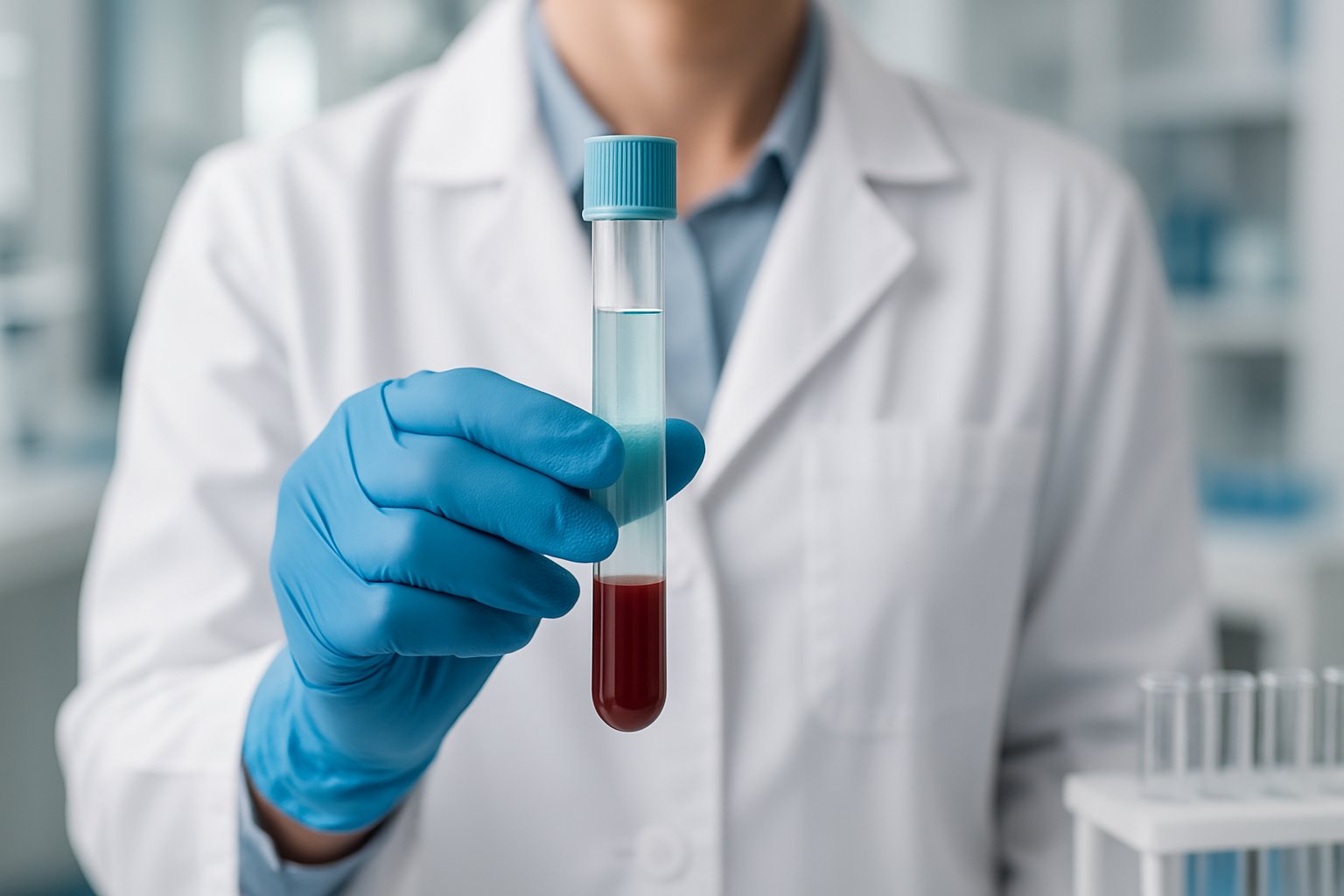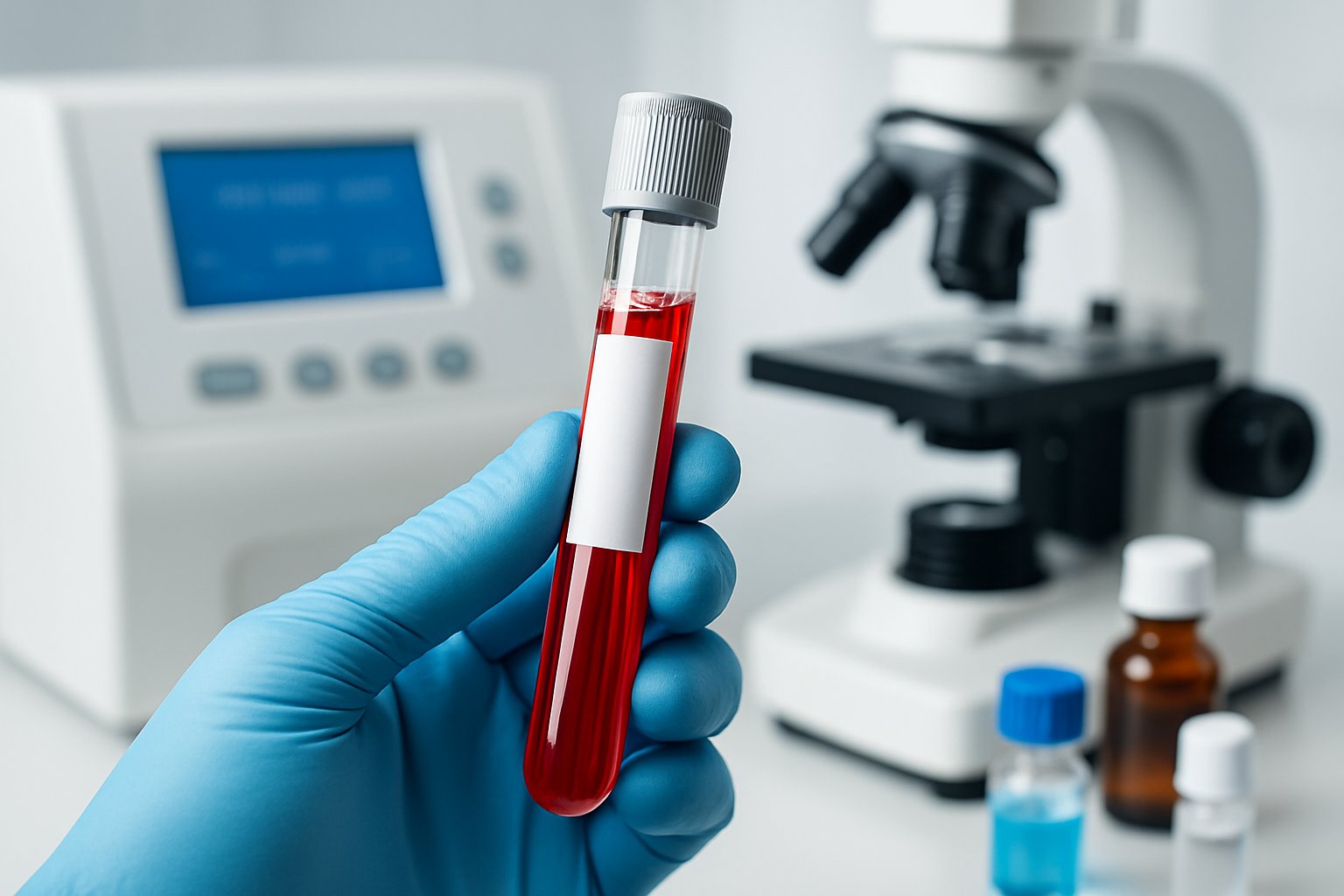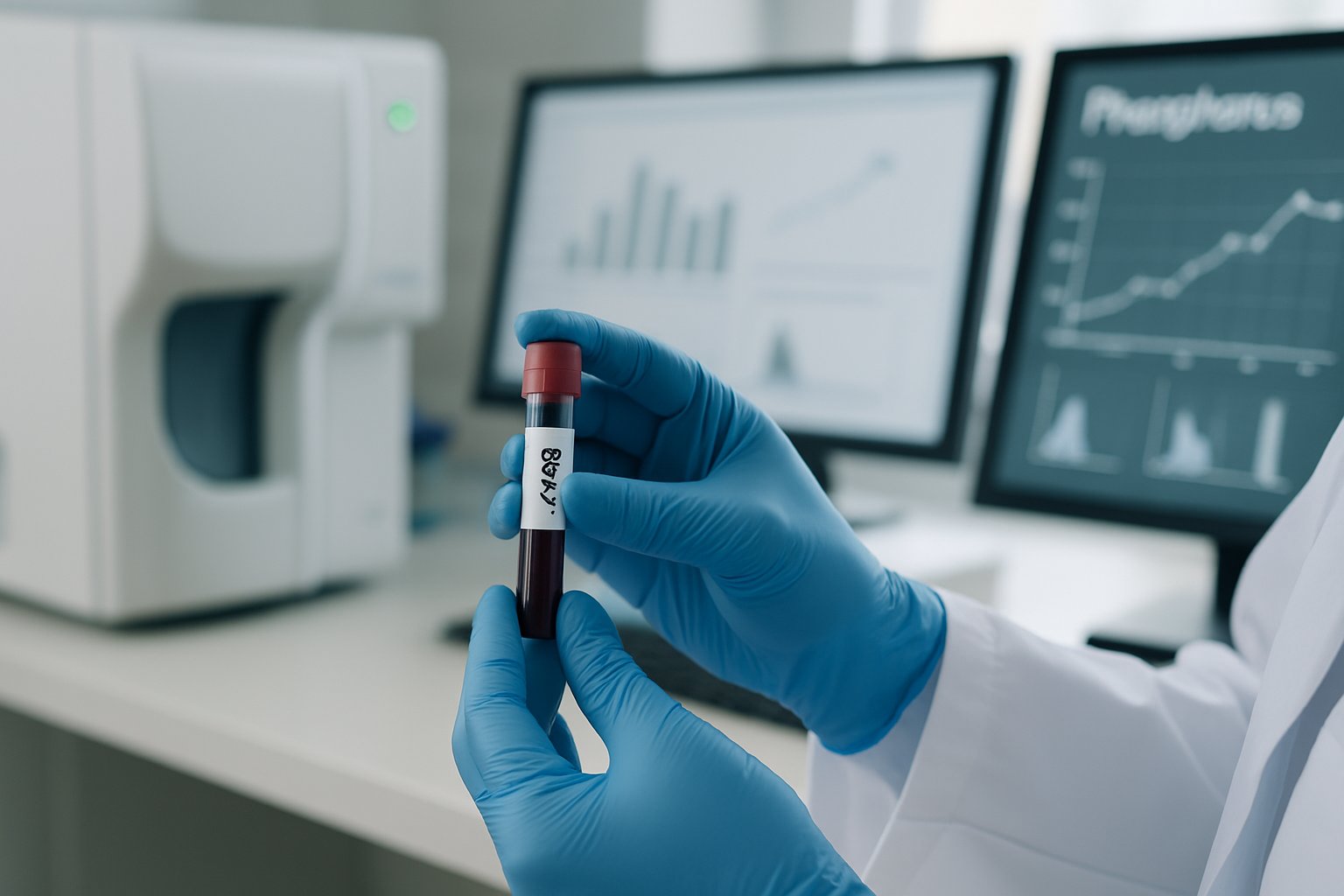Low blood phosphorus, also known as hypophosphatemia[1], occurs when phosphate levels in the blood drop below normal ranges. When blood phosphorus is low, the body struggles to maintain strong bones, proper muscle function, and nerve activity, which can lead to weakness, bone pain, and breathing problems in severe cases. This condition affects about 5% of people in the United States, though most cases are mild and cause no symptoms.

Phosphorus plays a vital role in the body’s daily functions. It helps build and repair bones and teeth, supports nerve communication, and allows muscles to contract properly. About 85% of the body’s phosphorus is stored in bones, while the rest circulates in blood and tissues throughout the body.
The severity of low blood phosphorus determines what happens next. Mild cases often go unnoticed and may not require treatment. However, severe hypophosphatemia can be life-threatening[1] and needs immediate medical attention. Understanding the causes, symptoms, and treatment options helps people recognize when to seek medical care.
Key Takeaways
- Low blood phosphorus weakens bones, muscles, and nerves, causing symptoms like fatigue and bone pain
- Mild cases are common and often harmless, but severe cases require immediate medical treatment
- Treatment involves addressing underlying causes and may include phosphorus supplements or dietary changes
Understanding Blood Phosphorus and Its Functions

Phosphorus works as a charged particle called phosphate in the blood and serves multiple critical roles in the body. The body relies on adequate phosphate levels for energy creation, bone strength, and proper cell function.
Phosphate as an Essential Electrolyte
Phosphate is an essential electrolyte[1] that carries an electrical charge in blood and body fluids. This charged particle contains the mineral phosphorus and helps maintain proper fluid balance.
The body stores about 85% of its phosphorus in bones and teeth. The remaining 15% circulates in blood and soft tissues throughout the body.
Phosphate levels work closely with calcium in the blood. When calcium levels go up, phosphate levels go down. This balance happens constantly throughout the day.
The parathyroid glands release a hormone called PTH that controls both calcium and phosphate levels. This hormone helps keep electrolyte levels stable.
People get phosphorus from food sources like dairy products, meat, fish, nuts, and beans. The digestive system absorbs this mineral and converts it to phosphate for use in the body.
Role of Phosphorus in Energy Production
Phosphate plays a key role in making energy at the cellular level. Cells use a molecule called ATP (adenosine triphosphate) to store and release energy for daily activities.
ATP contains three phosphate groups attached to adenosine. When cells need energy, they break off one phosphate group. This process releases energy that powers muscle contractions and other body functions.
The body constantly recycles phosphate to rebuild ATP molecules. Without enough phosphate in the blood, cells cannot make sufficient energy. This can lead to muscle weakness and fatigue.
Phosphate also helps activate many enzymes that control metabolism. These proteins speed up chemical reactions that break down food and create energy from nutrients.
During intense physical activity or illness recovery, the body uses large amounts of phosphate for energy production. This increased demand can sometimes lead to low blood phosphate levels.
Importance for Strong Bones and Teeth
Phosphorus combines with calcium to form calcium phosphate crystals in bones and teeth. These crystals give bones their hardness and strength.
Building and repairing bones and teeth[1] requires steady amounts of both calcium and phosphate. The body constantly breaks down old bone tissue and builds new tissue.
Bone cells called osteoblasts use phosphate to create new bone matrix. Without enough phosphate, bones become weak and may break more easily.
Growing children and teenagers need extra phosphate for bone development. Adults also need consistent phosphate levels to maintain bone density as they age.
Teeth contain even more phosphate than bones. The hard outer layer called enamel is mostly calcium phosphate. Adequate phosphate levels help keep teeth strong and resistant to decay.
What Is Low Blood Phosphorus (Hypophosphatemia)?

Low blood phosphorus occurs when serum phosphate levels drop below normal ranges, creating an electrolyte imbalance that can range from mild to life-threatening. This condition can develop suddenly or persist over time, affecting multiple body systems.
Normal Blood Phosphate Levels
Normal blood phosphate levels typically range from 2.5 to 4.5 mg/dL in healthy adults. These levels help maintain proper bone health and cellular function.
The kidneys play a key role in controlling phosphorus levels by removing excess phosphate from the body. When this system works properly, it keeps blood phosphorus in the normal range.
Phosphate levels can vary slightly throughout the day. They also change based on age, with children often having higher normal ranges than adults.
Blood tests measure serum phosphate to determine if levels are within the healthy range. Doctors use these results to diagnose hypophosphatemia when phosphate levels drop[1] below normal.
Definition and Types of Hypophosphatemia
Hypophosphatemia is defined as a serum phosphate concentration below 2.5 mg/dL[2]. Medical professionals classify this condition into different severity levels.
Mild hypophosphatemia occurs when levels drop slightly below normal but remain above 2.0 mg/dL. This form often causes no symptoms and may go unnoticed.
Moderate hypophosphatemia involves phosphate levels between 1.0 and 2.0 mg/dL. Patients may begin experiencing some symptoms at this stage.
Severe hypophosphatemia happens when levels fall below 1.0 mg/dL. This dangerous condition can cause serious complications and requires immediate medical attention.
Mild hypophosphatemia affects about 5% of people[1] in routine blood tests. However, severe cases are much less common in the general population.
Acute vs. Chronic Hypophosphatemia
Acute hypophosphatemia develops rapidly, with phosphorus levels dropping suddenly over hours or days. This form often occurs during recovery from serious illnesses.
Acute hypophosphatemia commonly affects people recovering from severe undernutrition, diabetic complications, or other critical conditions[3]. The body uses large amounts of phosphate during healing, causing levels to plummet.
Chronic hypophosphatemia develops slowly over weeks, months, or years. This type often results from ongoing medical conditions or long-term medication use.
Chronic cases may cause gradual bone weakness and muscle problems. Patients might not notice symptoms until the condition becomes more severe.
Both types require different treatment approaches. Acute cases need rapid correction, while chronic hypophosphatemia requires gradual phosphate replacement and treatment of underlying causes.
Causes and Risk Factors for Low Blood Phosphorus
Low blood phosphorus can happen when the body doesn’t get enough phosphorus, loses too much through the kidneys, or moves it around inside the body. Alcohol use disorder[4], certain medications, and medical conditions also increase the risk.
Reduced Intake or Poor Absorption
Malnutrition is one of the main causes of low phosphorus intake. People who don’t eat enough food or follow very strict diets may not get enough phosphorus from their meals.
Malabsorption happens when the intestines can’t take in phosphorus properly. This occurs in people with inflammatory bowel disease, celiac disease, or chronic diarrhea.
Alcohol use disorder makes the problem worse in two ways. It reduces food intake and damages the intestines’ ability to absorb nutrients. Chronic alcohol use[3] can lead to serious phosphorus deficiency.
Vitamin D deficiency also reduces phosphorus absorption. Vitamin D helps the intestines take in both calcium and phosphorus from food.
Increased Loss from the Kidneys
The kidneys control how much phosphorus stays in the body. Several conditions make the kidneys lose too much phosphorus.
Hyperparathyroidism causes high levels of parathyroid hormone. This hormone tells the kidneys to get rid of more phosphorus than normal.
Diuretics used for a long time can increase phosphorus loss through urine. These medications help remove extra fluid but also remove important minerals.
Dialysis removes phosphorus from the blood along with waste products. People on dialysis often need to watch their phosphorus levels carefully.
Cushing syndrome and other hormonal problems can also make the kidneys lose more phosphorus.
Redistribution Within the Body
Sometimes phosphorus levels drop because it moves from the blood into cells quickly. This doesn’t mean the body lacks phosphorus overall.
Refeeding syndrome happens when malnourished people start eating again. The body suddenly needs lots of phosphorus to build new cells and make energy.
Diabetic ketoacidosis treatment can cause phosphorus to shift into cells rapidly. Blood levels drop even though total body phosphorus might be normal.
Alkalosis makes phosphorus move from blood into cells. This can happen with severe vomiting or certain breathing problems.
Sepsis and severe infections also cause phosphorus redistribution as the body fights the infection.
Medications and Medical Conditions
Many medications can lower blood phosphorus levels. Aluminum-containing antacids are a common cause when used regularly.
Phosphate binders given to kidney disease patients can sometimes bind too much phosphorus. These medications are meant to control phosphorus but can cause levels to drop too low.
Other conditions that increase risk include:
- Hypomagnesemia (low magnesium)
- Hypokalemia (low potassium)
- Hypothyroidism
- Metabolic acidosis
These conditions often happen together and can make phosphorus problems worse. Medical treatment is needed[1] when multiple factors combine to cause severe phosphorus deficiency.
Signs and Symptoms of Low Blood Phosphorus

Low phosphorus levels can cause symptoms[1] ranging from mild fatigue to serious complications affecting the brain, muscles, and bones. The severity of symptoms depends on how quickly phosphorus drops and how low the levels become.
Common Early Symptoms
The first signs of low blood phosphorus often appear as general feelings of being unwell. Patients frequently experience fatigue that doesn’t improve with rest.
Loss of appetite is another common early warning sign. Many people notice they don’t want to eat as much as usual. This can quickly lead to anorexia in more severe cases.
Irritability becomes noticeable as phosphorus levels continue to drop. People may feel more easily frustrated or upset than normal. Family members often notice mood changes before the person realizes something is wrong.
These early symptoms can be easy to dismiss as stress or being tired. However, they often get worse without treatment and can lead to more serious problems.
Neurological and Cognitive Effects
The brain needs phosphorus to work properly, so low levels cause serious thinking problems. Confusion is one of the most common neurological symptoms people experience.
Numbness in the hands and feet occurs as nerve function becomes impaired. This tingling sensation can spread to other parts of the body as phosphorus levels drop further.
More severe cases can progress to delirium, where people become disoriented and may not recognize where they are. Seizures can happen when phosphorus levels become dangerously low.
The most serious neurological complication is coma. This life-threatening condition requires immediate medical attention and can be fatal without proper treatment.
Muscular and Skeletal Manifestations
Muscle weakness is often one of the first physical symptoms people notice. Simple tasks like climbing stairs or lifting objects become much harder than usual.
Bone pain develops because phosphorus is essential for bone strength. The pain typically affects multiple areas and gets worse over time.
Rhabdomyolysis is a dangerous condition where muscle tissue breaks down rapidly. This releases proteins into the blood that can damage the kidneys and other organs.
Low phosphorus also causes platelet dysfunction, which affects blood clotting. People may bruise more easily or have trouble stopping bleeding from small cuts.
Potential Complications of Untreated Hypophosphatemia

When blood phosphorus levels remain low without treatment, serious complications can develop across multiple body systems. These range from weakened bones and muscle damage to life-threatening heart problems and blood disorders.
Bone Disorders and Tooth Decay
Low phosphorus levels severely impact bone health because phosphorus works with calcium to build strong bones. Without enough phosphorus, bones become weak and brittle.
Adults with untreated hypophosphatemia develop osteomalacia. This condition causes bones to soften and bend easily. People experience deep bone pain that gets worse with movement.
Children face an even more serious problem called rickets. Their growing bones become deformed and curved. The legs may bow outward or inward as the soft bones cannot support body weight.
Chronic hypophosphatemia weakens bones[3], leading to frequent fractures from minor injuries. Even normal daily activities can cause bones to break.
Teeth also suffer when phosphorus levels stay low. Tooth decay happens faster because phosphorus helps keep tooth enamel strong. People may lose teeth or need extensive dental work.
Cardiac and Respiratory Complications
The heart muscle needs phosphorus to contract properly. When levels drop too low, dangerous heart problems can develop quickly.
Arrhythmias are abnormal heart rhythms that can be life-threatening. The heart may beat too fast, too slow, or irregularly. Some people feel their heart racing or skipping beats.
Severe cases can lead to heart failure. The weakened heart muscle cannot pump blood effectively throughout the body. People experience shortness of breath, swelling in their legs, and extreme fatigue.
Breathing problems also occur with very low phosphorus levels. The muscles used for breathing become weak and cannot work properly. This creates a dangerous condition called respiratory alkalosis where blood becomes too alkaline.
Some patients need mechanical ventilation because their breathing muscles fail completely.
Muscle and Blood Cell Problems
Phosphorus is essential for muscle function and blood cell health. Without enough phosphorus, severe complications develop in both areas.
Muscle damage happens when phosphorus levels drop critically low. Muscles break down and release proteins into the blood. This process is called rhabdomyolysis and can damage the kidneys.
People first notice muscle weakness in their arms and legs. Simple tasks like walking or lifting objects become difficult or impossible. The weakness gets progressively worse without treatment.
Blood cells also suffer from phosphorus deficiency. Red blood cells become fragile and break apart easily, causing hemolytic anemia. Patients feel tired, weak, and may look pale.
White blood cells stop working properly, making it harder to fight infections. People get sick more often and take longer to recover from illnesses.
Platelets, which help blood clot, also decrease in number and function poorly.
Other Serious Health Risks
Several other complications can develop when hypophosphatemia remains untreated. These problems affect metabolism and overall body function.
Glucose intolerance develops because cells cannot use sugar properly without enough phosphorus. Blood sugar levels may rise, leading to diabetes-like symptoms including increased thirst and urination.
The liver also shows signs of stress from low phosphorus levels. Liver function tests become abnormal as the organ struggles to perform its normal duties. Liver enzymes in the blood increase, showing cellular damage.
Brain function suffers as well. People may experience stupor, coma, and even death[3] when phosphorus levels become extremely low.
Kidney problems can develop from muscle breakdown products. The kidneys may fail to filter waste properly, creating additional health risks throughout the body.
Diagnosis and Monitoring of Blood Phosphorus Levels

Doctors use phosphate in blood tests[5] to measure phosphorus levels and identify problems. They also check for physical signs and look for conditions that might cause low phosphate levels.
Blood Tests and Lab Measurements
The main test for phosphorus is a serum phosphate measurement. This blood test shows the exact amount of phosphate in the blood.
Normal phosphate levels range from 2.5 to 4.5 mg/dL in adults. Levels below 2.5 mg/dL indicate hypophosphatemia.
Doctors often order additional tests alongside the phosphate test:
- Calcium levels – Phosphate and calcium work together in the body
- Vitamin D levels – Vitamin D helps the body absorb phosphorus
- Parathyroid hormone (PTH) – This hormone controls phosphate and calcium balance
- Kidney function tests – The kidneys help control phosphate levels
Blood phosphate levels can change throughout the day. Doctors may order multiple tests to get accurate readings.
Fasting is usually not required for phosphate testing. The test uses a simple blood draw from a vein in the arm.
Relevant Physical Exams and Assessments
Doctors look for physical signs that suggest low phosphorus levels. They check for muscle weakness and bone problems during the exam.
Muscle and nerve tests include checking reflexes and muscle strength. Low phosphate can cause muscles to feel weak or cramped.
Bone examination focuses on areas of pain or tenderness. The doctor may press on bones to check for soreness.
Heart and lung assessment is important because severe low phosphate can affect breathing and heart function. Doctors listen to the heart and lungs with a stethoscope.
Mental status evaluation helps identify confusion or changes in thinking. Low phosphate can sometimes affect brain function.
The doctor also asks about symptoms like fatigue, bone pain, or difficulty walking. These symptoms help confirm the diagnosis.
Identifying Underlying Causes
Finding the cause of low phosphorus is crucial for proper treatment. Doctors review medical history and current medications carefully.
Common medication causes include antacids, diuretics, and insulin. The doctor reviews all prescription and over-the-counter drugs.
Dietary assessment examines eating habits and nutrition. Poor diet or malabsorption can lower phosphate levels.
Medical conditions that affect phosphorus include kidney disease, diabetes, and alcohol use disorders. The doctor looks for signs of these conditions.
Laboratory investigations may include urine tests to see how much phosphate the kidneys are losing. This helps determine if the problem is in the kidneys or elsewhere.
Vitamin D deficiency testing is important because low vitamin D can reduce phosphorus absorption from food.
Treatment Strategies for Low Blood Phosphorus

Treatment for hypophosphatemia[6] involves dietary changes, phosphorus supplementation, and addressing root causes. The approach depends on how severe the deficiency is and what caused it.
Dietary Changes and Nutrition
Patients can increase phosphorus levels through specific food choices. Protein-rich foods contain the highest amounts of phosphate.
Dairy products like milk, cheese, and yogurt provide easily absorbed phosphorus. Fish such as salmon, tuna, and sardines offer excellent sources.
Nuts and seeds contain significant phosphate levels. Almonds, sunflower seeds, and pumpkin seeds work well. Legumes including beans, lentils, and chickpeas also help.
Whole grains provide phosphorus along with other nutrients. Brown rice, oats, and quinoa are good options.
Patients should limit foods that bind phosphorus. Antacids with aluminum or magnesium can reduce absorption. Some sodas contain phosphoric acid but may not be the best choice for overall health.
Working with a nutritionist helps create meal plans. They can calculate daily phosphorus intake and suggest specific foods.
Phosphorus Supplementation Options
Phosphate supplements[1] come in oral and intravenous forms. Doctors choose the method based on severity and patient needs.
Oral phosphate supplements work for mild to moderate cases. Common forms include:
- Sodium phosphate tablets
- Potassium phosphate capsules
- Liquid phosphate solutions
Patients typically take oral supplements with meals to improve absorption. Side effects may include stomach upset or diarrhea.
Intravenous phosphate treats severe phosphate deficiency. Hospitals use IV treatment when levels drop dangerously low. This method works faster than oral supplements.
Vitamin D supplements may help phosphorus absorption. The body needs vitamin D to use phosphate properly. Doctors often prescribe both together.
Regular blood tests monitor phosphorus levels during treatment. This helps doctors adjust dosing and prevent overcorrection.
Correction of Underlying Disorders
Treating the root cause[3] prevents phosphate deficiency from returning. Different conditions require specific approaches.
Malnutrition needs careful nutritional rehabilitation. Doctors slowly increase food intake to avoid refeeding syndrome. This condition can make phosphorus levels drop even more.
Alcohol use disorders require complete treatment programs. Stopping alcohol allows the body to absorb nutrients better. Patients often need thiamine and other vitamins too.
Kidney problems may need medication adjustments. Some drugs cause phosphorus loss through urine. Doctors might change doses or switch medications.
Hyperparathyroidism sometimes requires surgery. Overactive parathyroid glands cause phosphorus wasting. Removing problem glands can fix the imbalance.
Diabetes management helps prevent phosphate loss. Poor blood sugar control can affect mineral levels. Better diabetes care improves overall electrolyte balance.
Doctors monitor patients closely during treatment of underlying conditions. Phosphorus levels often improve as the main problem gets better.
Prevention and Long-Term Management

Preventing low phosphorus levels requires lifestyle changes and regular monitoring. Chronic hypophosphatemia[7] needs ongoing care to avoid complications and maintain healthy phosphate levels.
Risk Reduction and Healthy Lifestyle
A balanced diet provides the foundation for maintaining healthy phosphate levels. Foods rich in phosphorus include dairy products, meat, fish, eggs, and beans.
Patients should avoid large quantities of antacids[8] because they bind intestinal phosphate and block absorption. This is especially important for people with a history of low phosphorus.
Key dietary sources of phosphorus:
- Milk and cheese
- Chicken and beef
- Fish and shellfish
- Nuts and seeds
- Whole grains
Cow’s milk contains 1 mg of phosphate per milliliter. This makes it an excellent and accessible source of phosphorus for daily intake.
People with eating disorders need specialized counseling. Anorexia and bulimia can cause severe phosphorus deficiency that requires professional treatment.
Alcohol use should be limited. Heavy drinking can lead to malnutrition and increase the risk of refeeding syndrome when eating resumes.
Monitoring and Follow-Up
Follow-up phosphate tests help determine if someone had a temporary episode or chronic condition[8]. The frequency depends on the underlying cause and severity.
People with genetic phosphate wasting disorders need regular monitoring. Blood tests should check phosphorus, calcium, and vitamin D levels every few months.
Monitoring schedule for different conditions:
| Condition | Test Frequency | Key Markers |
|---|---|---|
| Temporary low phosphorus | One recheck | Phosphorus level |
| Chronic phosphate wasting | Every 3-4 months | Phosphorus, calcium, vitamin D |
| Eating disorder recovery | Monthly initially | Phosphorus, other electrolytes |
Bone density scans help assess long-term damage. These tests show if low phosphorus has affected bone strength over time.
Growth monitoring is crucial for children. Low phosphorus can cause rickets and affect normal development.
Special Considerations for Chronic Conditions
Patients with phosphate wasting syndromes need ongoing oral supplements[8]. These supplements help normalize phosphate levels and reduce bone pain.
People with kidney disease require special care. They may need active vitamin D supplements because their kidneys cannot process regular vitamin D properly.
Activity restrictions for severe cases:
- Avoid high-impact sports
- Use fall prevention measures
- Limit activities if muscle weakness occurs
Children with X-linked hypophosphatemia may benefit from newer treatments. Burosumab is an antibody treatment approved for certain genetic forms of the condition.
Patients taking phenytoin need extra vitamin D. This seizure medication interferes with vitamin D metabolism and can cause chronic phosphorus problems.
Regular dental care is important. Low phosphorus affects tooth development and bone health in the jaw.
Frequently Asked Questions
Low phosphate levels in blood[1] can stem from various medical conditions and may lead to serious health complications. Understanding the causes, warning signs, and risks helps patients recognize when medical attention becomes necessary.
What are the potential causes of hypophosphatemia?
Hyperparathyroidism and vitamin D deficiency[9] are the most common causes of low phosphate levels. These conditions affect how the body processes and maintains phosphate balance.
Other causes include malnutrition, alcohol withdrawal, and certain medications. Some people develop low phosphate levels during recovery from diabetic ketoacidosis or severe burns.
Kidney problems can also cause phosphate loss through urine. The body may get rid of too much phosphate[4] when kidney function is impaired.
How might cancer be related to decreased phosphate levels?
Cancer patients often develop low phosphate levels due to treatment effects and the disease process itself. Chemotherapy and radiation can damage cells that normally help maintain phosphate balance.
Tumor lysis syndrome occurs when cancer treatments cause rapid cell death. This process can quickly deplete phosphate stores in the body.
Poor nutrition during cancer treatment also contributes to phosphate deficiency. Many cancer patients eat less food, which reduces their phosphate intake.
What indicators might suggest a dangerous level of low phosphorus?
Severe muscle weakness and difficulty breathing indicate dangerously low phosphate levels. These symptoms occur when muscles cannot function properly without adequate phosphate.
Confusion, seizures, or changes in mental status signal severe hypophosphatemia. The brain needs phosphate to function normally and maintain nerve connections.
Heart rhythm problems can develop when phosphate levels drop too low. The heart muscle requires phosphate to contract effectively and maintain steady beats.
What are the possible complications associated with low phosphate levels?
Bone problems develop when phosphate levels stay low for extended periods. Phosphate is essential for building and repairing bones and teeth[1], so deficiency can lead to fractures and bone pain.
Muscle breakdown occurs in severe cases of hypophosphatemia. Without enough phosphate, muscle fibers cannot maintain their structure and begin to deteriorate.
Breathing difficulties may arise when respiratory muscles weaken. This complication can become life-threatening if not treated promptly.
Blood cell problems can develop, including anemia and reduced white blood cell function. This makes patients more susceptible to infections and bleeding.
What are the common symptoms of hypophosphatemia as identified by health services?
Mild hypophosphatemia typically doesn’t cause symptoms[1] and affects about 5% of people in routine blood tests. Most people with mild cases feel completely normal.
Moderate to severe cases cause muscle weakness and bone pain. Patients may notice difficulty climbing stairs or lifting objects they could handle before.
Fatigue and irritability often develop as phosphate levels decrease. Phosphate helps with energy production[10] in cells throughout the body.
Tingling sensations in hands and feet indicate nerve function problems. This happens because phosphate is needed for proper nerve conduction.
Is hypophosphatemia considered a life-threatening condition?
Severe hypophosphatemia can be life-threatening[1] and requires immediate medical treatment. The condition becomes dangerous when it affects heart, lung, or brain function.
Mild cases rarely pose serious health risks. Most people with slightly low phosphate levels can manage the condition with dietary changes or supplements.
Acute hypophosphatemia develops suddenly[3] and carries higher risks than chronic forms. This type often occurs during recovery from serious illnesses.
The danger level depends on how quickly phosphate drops and the patient’s overall health. People with other medical conditions face higher risks from low phosphate levels.
References
- Hypophosphatemia: What It Is, Causes, Symptoms & Treatment. https://my.clevelandclinic.org/health/diseases/24040-hypophosphatemia Accessed October 27, 2025
- Hypophosphatemia - Endocrine and Metabolic Disorders. https://www.msdmanuals.com/professional/endocrine-and-metabolic-disorders/electrolyte-disorders/hypophosphatemia Accessed October 27, 2025
- Hypophosphatemia (Low Level of Phosphate in the Blood) - Hormonal and Metabolic Disorders. https://www.merckmanuals.com/home/hormonal-and-metabolic-disorders/electrolyte-balance/hypophosphatemia-low-level-of-phosphate-in-the-blood Accessed October 27, 2025
- Hypophosphatemia. https://www.drugs.com/cg/hypophosphatemia.html Accessed October 27, 2025
- Phosphate in Blood: MedlinePlus Medical Test. https://medlineplus.gov/lab-tests/phosphate-in-blood/ Accessed October 27, 2025
- Low Phosphate Levels (Hypophosphatemia): Treatment, Symptoms, Causes. https://www.emedicinehealth.com/how_to_increase_phosphate_levels_hypophosphatemia/article_em.htm Accessed October 27, 2025
- Hypophosphatemia (Low Level of Phosphate in the Blood) - Hormonal and Metabolic Disorders. https://www.msdmanuals.com/home/hormonal-and-metabolic-disorders/electrolyte-balance/hypophosphatemia-low-level-of-phosphate-in-the-blood Accessed October 27, 2025
- Hypophosphatemia Treatment & Management: Medical Care, Surgical Care, Consultations. https://emedicine.medscape.com/article/242280-treatment Accessed October 27, 2025
- Hypophosphataemia. https://www.yourhormones.info/endocrine-conditions/hypophosphataemia/ Accessed October 27, 2025
- 403 Forbidden. https://www.apollohospitals.com/diseases-and-conditions/hypophosphatemia Accessed October 27, 2025
